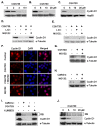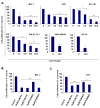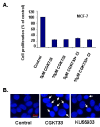The ATM and ATR inhibitors CGK733 and caffeine suppress cyclin D1 levels and inhibit cell proliferation
- PMID: 19903334
- PMCID: PMC2777912
- DOI: 10.1186/1748-717X-4-51
The ATM and ATR inhibitors CGK733 and caffeine suppress cyclin D1 levels and inhibit cell proliferation
Abstract
The ataxia telangiectasia mutated (ATM) and the ATM- related (ATR) kinases play a central role in facilitating the resistance of cancer cells to genotoxic treatment regimens. The components of the ATM and ATR regulated signaling pathways thus provide attractive pharmacological targets, since their inhibition enhances cellular sensitivity to chemo- and radiotherapy. Caffeine as well as more specific inhibitors of ATM (KU55933) or ATM and ATR (CGK733) have recently been shown to induce cell death in drug-induced senescent tumor cells. Addition of these agents to cancer cells previously rendered senescent by exposure to genotoxins suppressed the ATM mediated p21 expression required for the survival of these cells. The precise molecular pharmacology of these agents however, is not well characterized. Herein, we report that caffeine, CGK733, and to a lesser extent KU55933, inhibit the proliferation of otherwise untreated human cancer and non-transformed mouse fibroblast cell lines. Exposure of human cancer cell lines to caffeine and CGK733 was associated with a rapid decline in cyclin D1 protein levels and a reduction in the levels of both phosphorylated and total retinoblastoma protein (RB). Our studies suggest that observations based on the effects of these compounds on cell proliferation and survival must be interpreted with caution. The differential effects of caffeine/CGK733 and KU55933 on cyclin D1 protein levels suggest that these agents will exhibit dissimilar molecular pharmacological profiles.
Figures



Similar articles
-
Small molecule-based reversible reprogramming of cellular lifespan.Nat Chem Biol. 2006 Jul;2(7):369-74. doi: 10.1038/nchembio800. Epub 2006 Jun 11. Nat Chem Biol. 2006. Retraction in: Nat Chem Biol. 2008 Jul;4(7):431. doi: 10.1038/nchembio0708-431 PMID: 16767085 Retracted.
-
Ataxia telangiectasia mutated and p21CIP1 modulate cell survival of drug-induced senescent tumor cells: implications for chemotherapy.Clin Cancer Res. 2008 Mar 15;14(6):1877-87. doi: 10.1158/1078-0432.CCR-07-4298. Clin Cancer Res. 2008. PMID: 18347191
-
CGK733 does not inhibit ATM or ATR kinase activity in H460 human lung cancer cells.DNA Repair (Amst). 2011 Oct 10;10(10):1000-1; author reply 1002. doi: 10.1016/j.dnarep.2011.07.013. Epub 2011 Aug 23. DNA Repair (Amst). 2011. PMID: 21865098 Free PMC article. No abstract available.
-
Banking on ATM as a new target in metabolic syndrome.Cell Metab. 2006 Nov;4(5):337-8. doi: 10.1016/j.cmet.2006.10.009. Cell Metab. 2006. PMID: 17084707 Review.
-
ATM as a target for novel radiosensitizers.Semin Radiat Oncol. 2001 Oct;11(4):316-27. doi: 10.1053/srao.2001.26030. Semin Radiat Oncol. 2001. PMID: 11677656 Review.
Cited by
-
Coffee provides a natural multitarget pharmacopeia against the hallmarks of cancer.Genes Nutr. 2015 Nov;10(6):51. doi: 10.1007/s12263-015-0501-3. Epub 2015 Nov 17. Genes Nutr. 2015. PMID: 26577824 Free PMC article.
-
Regulation of ionizing radiation-induced adhesion of breast cancer cells to fibronectin by alpha5beta1 integrin.Radiat Res. 2014 Jun;181(6):650-8. doi: 10.1667/RR13543.1. Epub 2014 May 1. Radiat Res. 2014. PMID: 24785587 Free PMC article.
-
Caffeine as a tool for investigating the integration of Cdc25 phosphorylation, activity and ubiquitin-dependent degradation in Schizosaccharomyces pombe.Cell Div. 2020 Jun 29;15:10. doi: 10.1186/s13008-020-00066-1. eCollection 2020. Cell Div. 2020. PMID: 32612670 Free PMC article. Review.
-
GABA maintains the proliferation of progenitors in the developing chick ciliary marginal zone and non-pigmented ciliary epithelium.PLoS One. 2012;7(5):e36874. doi: 10.1371/journal.pone.0036874. Epub 2012 May 9. PLoS One. 2012. PMID: 22590629 Free PMC article.
-
The adherens junction protein afadin is an AKT substrate that regulates breast cancer cell migration.Mol Cancer Res. 2014 Mar;12(3):464-76. doi: 10.1158/1541-7786.MCR-13-0398. Epub 2013 Nov 22. Mol Cancer Res. 2014. PMID: 24269953 Free PMC article.
References
-
- Alao JP. The ATM regulated DNA damage response pathway as a chemo- and radiosensitization target. Expert Opinion on Drug Discovery. 2009;4:495–505. doi: 10.1517/17460440902835475. - DOI
Publication types
MeSH terms
Substances
LinkOut - more resources
Full Text Sources
Medical
Molecular Biology Databases
Research Materials
Miscellaneous

